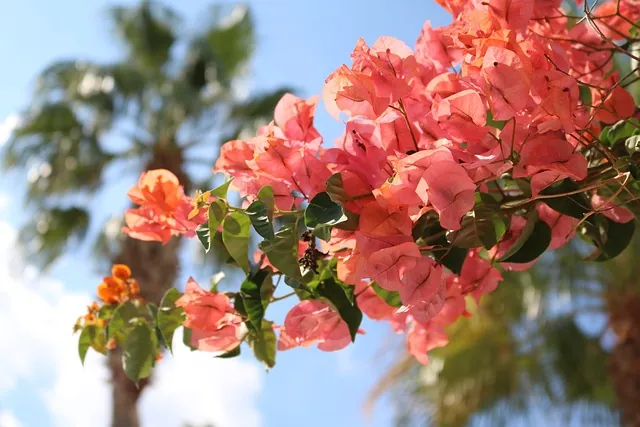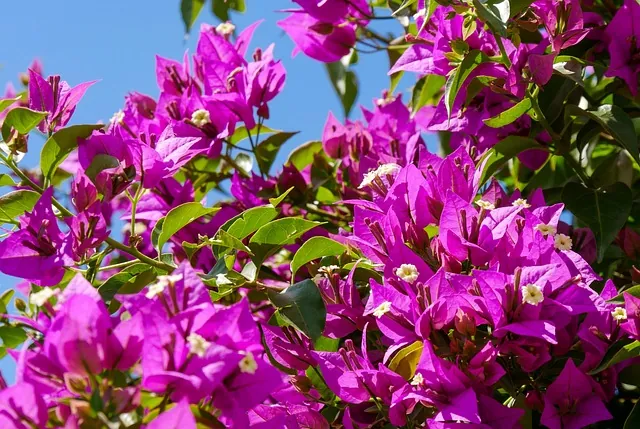 Bougainvillea is a vibrant tropical plant that thrives in Australia’s diverse climate. When grown in pots, it’s perfect for adding a splash of colour to patios, balconies, and gardens. This guide covers everything from selecting the right variety to caring for your bougainvillea after planting.
Bougainvillea is a vibrant tropical plant that thrives in Australia’s diverse climate. When grown in pots, it’s perfect for adding a splash of colour to patios, balconies, and gardens. This guide covers everything from selecting the right variety to caring for your bougainvillea after planting.
Key Topics:
- Variety Selection: Choosing bougainvillea varieties suited to Australia’s climate.
- Potting Mix: Creating the ideal potting mix for optimal growth.
- Planting and Training: Proper techniques for planting and shaping your bougainvillea.
- Care and Maintenance: Tips for watering, fertilizing, pruning, and pest control.
By following these guidelines, you can successfully cultivate beautiful and healthy bougainvillea plants in pots, enhancing the beauty of your outdoor space.
Pro Tip: Add two or three in a Rectangle Trough Planter and allow to climb up the side of a building or structure.
Varieties Suitable for Pots in Australia
Some bougainvillea varieties are particularly well-suited for container growing in Australia:
- “Bambino” series – compact growth, ideal for small spaces.
- “Singapore Pink” – tolerant of various climates, suitable for pots.
- “Golden Gem” – drought-tolerant, perfect for arid regions.
- “Raspberry Ice” – variegated foliage, adds interest even when not in bloom.
- “Vera Deep Purple” – compact variety, suitable for cooler regions.
Climate Considerations in Australia
Australia’s climate varies significantly from tropical in the north to temperate in the south. This diversity means that bougainvillea care may need to be adjusted depending on your specific location:
- Tropical North: Hot and humid year-round, ideal for bougainvillea growth.
- Subtropical East Coast: Warm and humid, excellent for bougainvillea with some winter protection.
- Arid Interior: Hot and dry, requiring extra attention to watering and sun protection.
- Mediterranean South: Mild winters and hot summers, suitable with frost protection.
- Temperate Southeast: Cool winters and warm summers, may need winter protection and a sheltered position.
Choosing the Right Pot
Selecting an appropriate pot is crucial for successful bougainvillea growth:
- Size: Start with a pot 40-50cm in diameter. Bougainvilleas prefer to be slightly root-bound.
- Drainage: Ensure the pot has adequate drainage holes to prevent waterlogging.
- Material: Lightweight concrete planters are strong and durable and offer a great neutral coloured back drop to the bright flowers
Soil and Potting Mix
A well-draining potting mix is essential for bougainvillea health:
- Use a high-quality potting mix designed for flowering plants.
- Add perlite or coarse sand to improve drainage.
- Aim for a slightly acidic to neutral pH (6.0-7.0).
- Consider adding slow-release fertilizer to the mix when planting.
Planting Your Bougainvillea
Follow these steps when planting your bougainvillea:
- Fill the pot about one-third full with potting mix.
- Gently remove the plant from its nursery container, taking care not to damage the roots.
- Place the plant in the centre of the new pot, ensuring it’s at the same depth as it was in the original container.
- Fill around the root ball with potting mix, firming gently to eliminate air pockets.
- Water thoroughly after planting to settle the soil.

Sunlight Requirements
Bougainvilleas thrive in full sun across Australia:
- Aim for at least 6 hours of direct sunlight daily.
- In extremely hot areas like the interior, some afternoon shade may be beneficial.
- Rotate the pot regularly to ensure even growth and flowering.
Watering Practices
Proper watering is crucial, especially given Australia’s often hot and dry conditions:
- Allow the top inch of soil to dry out between waterings.
- Water deeply when you do water, ensuring it drains freely from the bottom of the pot.
- Reduce watering in winter, especially in cooler regions.
- In tropical areas, maintain consistent moisture during the wet season but avoid waterlogging.
Fertilising Your Bougainvillea
Regular feeding is important for abundant blooms:
- Use a balanced, water-soluble fertiliser every 2-3 weeks during the growing season.
- Choose a fertiliser high in phosphorus to encourage flowering (e.g., 5-10-5 or 10-20-10).
- In tropical regions, fertilise year-round. In cooler areas, reduce or stop fertilising in winter.
Pruning and Training
Regular pruning helps maintain shape and encourages blooming:
- Prune after each flowering cycle to promote new growth.
- Remove dead, damaged, or crossing branches.
- Pinch out growing tips to encourage bushier growth.
- For climbing varieties, provide a trellis or support structure and train the vines as they grow.

Winter Care in Australia
Winter care varies depending on your location:
- Tropical North: Continue regular care with slightly reduced watering.
- Subtropical Areas: Protect from occasional frosts by moving pots to sheltered areas.
- Temperate Regions: Move pots to a protected area or indoors when temperatures drop below 10°C.
- Reduce watering and stop fertilizing during winter dormancy in cooler regions.
Pest and Disease Management
While generally hardy, bougainvilleas can face some issues in Australia:
- Watch for aphids, mealybugs, and spider mites, especially in humid conditions.
- Treat pest infestations with insecticidal soap or neem oil.
- Prevent fungal diseases by avoiding overhead watering and ensuring good air circulation.
- In humid tropical areas, be vigilant for signs of root rot and adjust watering accordingly.
Repotting
Repot your bougainvillea every 2-3 years or when it outgrows its current container:
- Choose a pot only slightly larger than the current one.
- Repot in spring before new growth begins.
- Gently loosen the root ball and trim any circling roots before replanting.
- Use fresh potting mix when repotting.
Encouraging Blooms in Australia’s Climate
To maximize flowering:
- Ensure the plant receives adequate sunlight – crucial in all Australian climates.
- Allow the soil to dry slightly between waterings, especially in humid regions.
- Use a fertilizer high in phosphorus during the growing season.
- Prune regularly to encourage new growth, which bears the flowers.
- In arid regions, provide a period of drought stress followed by thorough watering to trigger blooming.

Adapting to Specific Australian Climates
- Tropical North (e.g., Darwin, Cairns):
- Choose heat-tolerant varieties.
- Provide some afternoon shade to prevent leaf scorch.
- Monitor for pests more frequently due to high humidity.
- Subtropical East Coast (e.g., Brisbane, Gold Coast):
- Ideal climate for most bougainvillea varieties.
- Ensure good air circulation to prevent fungal issues in humid conditions.
- Protect from occasional winter frosts.
- Arid Interior (e.g., Alice Springs):
- Select drought-tolerant varieties.
- Use moisture-retaining mulch to conserve water.
- Provide shade during the hottest part of the day.
- Mediterranean South (e.g., Perth, Adelaide):
- Choose varieties that can tolerate occasional frost.
- Protect from strong winds, which can damage delicate blooms.
- Reduce watering significantly during the dry summer months.
- Temperate Southeast (e.g., Melbourne, Hobart):
- Select cold-hardy varieties.
- Provide winter protection or move pots indoors during cold spells.
- Ensure maximum sun exposure during the cooler months.
Common Problems and Solutions
- Leaf drop: Often caused by sudden changes in temperature or watering. Maintain consistent care and protect from extreme weather.
- Lack of blooms: Usually due to insufficient light or over-fertilizing with nitrogen. Increase sunlight exposure and use a balanced fertilizer.
- Yellowing leaves: Can indicate overwatering or nutrient deficiency. Adjust watering and fertilizing accordingly.
- Leggy growth: Typically caused by insufficient light. Move to a sunnier location and prune to encourage bushier growth.
- Frost damage: Protect plants in cooler regions by moving pots to sheltered areas or covering them during frost events.
Additional Tips for Success in Australia
- Choose varieties suited to your specific climate zone for best results.
- In coastal areas, be mindful of salt spray which can damage foliage. Rinse leaves occasionally if exposed.
- Use light-coloured pots in hot regions to keep root temperatures down.
- In humid areas, space pots to allow for good air circulation and prevent fungal issues.
- Consider using self-watering pots in arid regions to maintain consistent moisture levels.
Conclusion
Growing bougainvillea in pots is an excellent way to enjoy these vibrant plants across Australia’s diverse climate zones. By understanding the specific needs of bougainvilleas and adapting care to your local conditions, you can successfully cultivate these stunning plants. Whether you’re in the tropical north, the arid interior, or the temperate south, with proper care and attention, your potted bougainvilleas can thrive, bringing a burst of colour and tropical charm to your outdoor space. Remember to choose appropriate varieties, provide adequate sunlight, water judiciously, and protect from extreme weather conditions. With these considerations in mind, you’ll be well on your way to enjoying the beauty of bougainvilleas in your Australian garden.



Hello. Great article. I have a bougainvillea in a 30cm plastic pot with plenty of drainage holes. It continually flowers however the branches don’t seem to be growing in length/height. It’s only about 2 years old. I’ve tried pruning it to stimulate the growth, it’s also in full hot sun. Any recommendations as to how to stimulate the growth?
Based on the information provided, here are some recommendations to help stimulate growth in your potted bougainvillea:
Repot into a larger container: Your bougainvillea may be rootbound in the 30cm pot, which can restrict growth. Consider repotting into a pot that’s 1-2 sizes larger with fresh potting mix. This will give the roots more room to expand.
Fertilize regularly: Use a balanced, water-soluble fertilizer formulated for flowering plants every 2-3 weeks during the growing season. A fertilizer high in phosphorus can encourage both flowering and growth.
Prune strategically: While you’ve tried pruning, focus on removing any dead, damaged or crossing branches. Pinch out growing tips to encourage bushier growth rather than just height.
Check watering: Ensure you’re watering deeply but allowing the soil to dry slightly between waterings. Overwatering can stunt growth.
Provide support: If you want the plant to grow taller, consider adding a trellis or support structure for it to climb.
Adjust sunlight: While bougainvilleas love full sun, in very hot climates some afternoon shade can be beneficial. Make sure it’s getting at least 6 hours of direct sunlight daily.
Monitor for pests: Check for any signs of pests or diseases that could be hindering growth.
Be patient: Bougainvilleas can take a few years to really take off in growth, especially when container-grown. Consistent care should eventually lead to more vigorous growth.
If these steps don’t help after a few months, the plant may benefit from root pruning and repotting to reinvigorate its growth.